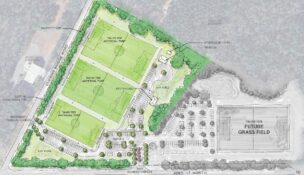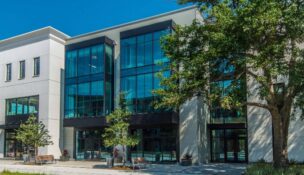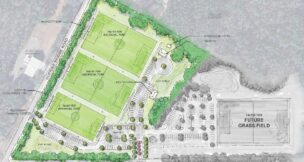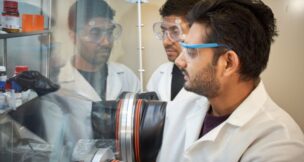Medal of Honor Museum charting new course
Staff //July 17, 2018//
Joe Daniels’ office at the base of the Arthur Ravenel Jr. Bridge is filled with relics of his former life as CEO of the National 9/11 Memorial and Museum — photos with former presidents and New York City mayors line the walls, along with photos and items from the museum itself.
But just outside his window, the view shifts to the future. Right now it’s just an expanse of grass and wetlands at the foot of the USS Yorktown; 10 years from now, visitors from around the country will be there to see the National Medal of Honor Museum.
“When this came along, I found a lot of parallels (to the 9/11 Memorial and Museum) — the idea that these stories of the best of the best of who we are, guys that literally jump on grenades to protect their brothers in arms and sacrifice so much of themselves for our country,” Daniels said. “This same notion that at the National Medal of Honor Museum, we can create something so powerful that when visitors experience it, it’s going to really change the way they look at their fellow Americans and change the way they live.”
C.png) Plans for the museum have been in the works for about five years, but fundraising for the project has stagnated and public support has wavered. Mount Pleasant’s Planning Commission did not recommend approval of the museum’s design in January, based on its height, which was 78 feet above the limit for new buildings in Mount Pleasant. At the beginning of April, on Daniels’ first day as CEO, the town’s Planning Committee deferred its decision on the project.
Plans for the museum have been in the works for about five years, but fundraising for the project has stagnated and public support has wavered. Mount Pleasant’s Planning Commission did not recommend approval of the museum’s design in January, based on its height, which was 78 feet above the limit for new buildings in Mount Pleasant. At the beginning of April, on Daniels’ first day as CEO, the town’s Planning Committee deferred its decision on the project.
Daniels said one of his top priorities is to work more closely with Mount Pleasant and its citizens.
“It’s going to require sort of a real collective effort and also drawing on all of my past experiences,” he said. “I got here and there was a sort of less-than-collegial atmosphere with … this organization and the town and the surrounding region, frankly; and I think that you can’t have a successful project that’s being built fundamentally on public land without a real deep partnership in the community.”
Part of the collective effort, Daniels said, is scrapping the previous design for the museum and listening to what the community wants for the National Medal of Honor Museum.
“There had never been a real process of engaging the community to listen and, fundamentally, listen to their hopes and aspirations when they think of this museum in their community,” he said. “And as far as I’m concerned, from my 9/11 experience, it’s just critical to do that.”
The Medal of Honor Museum Foundation is holding three public meetings about the project; the first was at the end of June aboard the USS Yorktown, where Daniels and architect Moshe Safdie talked about the process of designing a museum that captures the spirit of the Medal of Honor and the Lowcountry.
“There is no greater challenge for an architect to design a complex which has to rise up to the occasion of its symbolic significance,” Safdie said. “It’s not just a question of function, it’s not a question of making it work. It’s a question of touching the soul of those who are there, and it is question of honoring the recipients and their story.”
Reactions during the meeting were mainly positive, with few people voicing concerns about locating the museum in Mount Pleasant. No designs were presented at the meeting, which Safdie said made him skeptical initially. But he was pleasantly surprised by the feedback, he said, and he plans to come back at the end of July with multiple designs for the community to discuss.
Safdie also created the original Medal of Honor Museum design. Daniels said he’s not looking for any specific design, though some elements from the previous design may carry over.
“It really needs to be both iconic and reverential because it has to befit the mission of the National Medal of Honor itself,” Daniels said.
He said he envisions the museum as a place that inspires courage in young people to stand up for themselves and others, as well as a place that helps bring a divided nation together.
“I see this museum having a real potential, at this time in our 240-year-plus history as a country, for reminding people what it means to be American in a very open and ‘come together’ and compassionate and courageous way, if we do it right,” Daniels said.
The museum will present multiple design alternatives for the museum at the next public meeting, set for July 26, which Daniels said he was nervous and excited for.
“We want to do this right from the first time,” he said. “So our intention is to listen, and it’s going to be reflective of how we’re going to build this museum going forward. It’s going to be a much more open, transparent, collaborative endeavor with the folks from Charleston, Mount Pleasant, and then the surrounding counties and state.”
Board changes
One key to pushing the museum forward, Daniels said, is expanding the foundation’s board of directors. Currently the board comprises six members; about a third of the 19-member board resigned in February 2017 over disagreements about the leadership and vision for the museum, and others have ended up leaving since then.
Daniels said he could see potentially offering some donors a seat on the board if they were particularly passionate about the project.
“It’s a great thing for a potential major donor who really cares about the project and the community,” he said. “There’s opportunities to join the board and not only give financial leadership, but, you know, actual board and governing leadership.”
The board also has a new chairman: Peter Stent, a philanthropist and rancher in Nevada. Stent takes over for Bill Phillips, who left for personal reasons in early June, according to Stent.
“He’s a class act and really cares about the project,” Stent said, adding that no ill will exists between Phillips and the foundation.
Stent said he was “extraordinarily encouraged” by June’s public meeting. He expected more neutrality, or even negativity, he said, but he was emboldened by the community’s support and by Daniels’ vision.
“We’re so fortunate to have Joe,” Stent said.
Fundraising
Daniels said another of his main areas of focus is the “serious, serious endeavor” of fundraising.
“As a nonprofit, particularly at this stage of building, there’s no other revenue source other than the kindness of supporters, neighbors and strangers to rely on,” he said. “And that’s not a revenue source you can count on — you have to work really hard for it.”
The foundation has about $19 million in the bank, Daniels said — about the same amount former CEO Mark Updegrove said had been raised at this time last year. The museum needs to raise over $100 million.
Daniels said donors may have been hesitant to donate in part because they felt the community was not on board with the project.
“People and companies give for all kinds of reasons,” he said. “Companies oftentimes give because they want to show their support for the community and what the community is doing. And if the community is not fully embracing the project, if I was them, I might say, ‘Let’s see if they can get to a point where the community’s behind it before we give,’ which is exactly … our objective.”
Although fundraising has been efforts have been stalled, Daniels said he’s preparing to approach major donors about contributing to the museum. By the end of this year, Daniels said, he wants to have concrete numbers that show the progress the museum is making.
“It needs to be a real number, real step toward that $100 million goal,” he said. “It will show people that we had teed it up and now we’ve started doing major fundraising.”
The goal is to open the museum on Medal of Honor Day less than five years from now — March 25, 2023.
“There’ll be every living recipient, all the living presidents, thousands of veterans and their families, thousands of flag-waving Americans right over there when we cut the ribbon for the first time,” Daniels said.
This story originally appeared in the July 9, 2018, print edition of the Charleston Regional Business Journal.
















